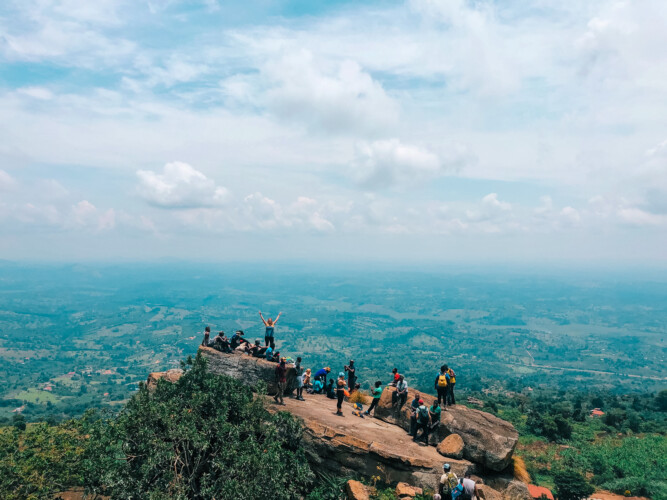Trace the historical Kampala Railway Line across town, through bustling markets, industrial areas and back-alleys, and end it with delicious fish and a cool beer at Port Bell.
Take a Sunday walk along parts of what was one of the biggest construction projects the British government undertook in sub-Saharan Africa during the colonial days: the Uganda Railway.
Description
This Kampala trail is a perfect Sunday outting. Starting from Nateete, follow the train tracks east to the railway workshop in Nalukolongo. Continue through Ndeeba, Kibuye and Nsambya to the Kampala terminus, then take the junction at Mukwano to Namuwongo and finish at Port Bell Luzira.
Trip Highlights
- Take a stroll through history along the railway that first connected Uganda to the Kenyan coast.
- Explore Kampala from a striking new vantage point.
- Enjoy succulent fish and a refreshing drink at Port Bell on the shores of Lake Victoria.
Mogo wa’Kebiro, a Gikuyu medicine man, once prophesied that colonists would one day bring an iron snake with as many legs as monyongoro (centipede), and that this iron snake would spit fire and stretch from the big water in the east to another big water in the west of the Gikuyu country. How right he would be.
The Uganda Railway, originally 1,060-kilometre (660 mi) length, was built during the scramble for Africa to link the interiors of Uganda and Kenya with the Indian Ocean port of Mombasa in Kenya. The debate on the actual motive for the construction still persists: while some believe the motive was of military and political nature (effectively cementing British control of the source of the Nile and, by extension, Egypt), others believe it was a commercial ploy to gain greater access to the raw materials of Kenya and Uganda.
Construction began at Mombasa in British East Africa in 1896 and finished at the line’s terminus, Port Florence (Kisumu), on the eastern shore of Lake Victoria, in 1901. By the time the railway reached Kisumu, the area was still part of Uganda. However, in April 1902, Port Florence, during the redrawing of the border between the two British protectorates, was transferred westwards and became part of present-day Kenya.
The first railway into present-day Uganda was extended in the mid-1920s from Nakuru to Soroti through Tororo in 1929 before coming down to Jinja through Namasagali. The railway finally reached Kampala in 1931 before being extended to Kasese in western Uganda where it reached in 1956 and the northern line reaching Arua in 1964.
200,000 individual 9-metre (30 ft) rail lengths and 1.2 million sleepers, 200,000 fish plates, 400,000 fish bolts and 4.8 million steel keys plus steel girders for viaducts and causeways had to be imported from India, necessitating the creation of a modern port at Kilindini Harbor in Mombasa. The railway was a huge logistical achievement and became strategically and economically vital for both Uganda and Kenya. It helped to suppress slavery, by removing the need for humans in the transport of goods.
A total of 35,729 workers were recruited from India along with 1,082 subordinate officers, totalling 36,811 persons. While most of the surviving Indians eventually returned home, 6,724 decided to remain after the line’s completion, creating a community of Indians in East Africa.
The construction of the railway was not without challenges. About 6,500 Indian workers were badly wounded and became incapacitated, while 2,500 died, mainly from tropical disease. The number of Africans who were injured or died on the project was not recorded. Externally, the incidents for which the building of the railway may be most noted are the killings of a number of construction workers in 1898, during the building of a bridge across the Tsavo River. Hunting mainly at night, a pair of mane-less male lions stalked and killed at least 28 Indian and African workers – although some accounts put the number of victims as high as 135.
[Based on the article “History of Uganda Railway”, The Daily Monitor (April 18, 2015), written by Andrew Lubega]
The Start: Nateete
Nateete is a bustling business metropolitan area located approximately 8km from Kampala CBD along the main highway between Kampala and Masaka.
Legend has it that the name “Nateete” was adopted from Luteete, the bush that covered the expanse of the area before human settlement.
The in-between:
From Nateete, your journey will take you through the busy trading centres of Ndeeba, Kibuye, Nsambya, Namuwongo. Throughout the trail, hikers should expect to be treated to the sights and sounds of the ordinary Ugandan’s hustle and a view of some of the 7 hills that make up Kampala and popular places like Soweto with its seven zones, namely: Industrial Area View, Go-Down, Kasanvu, Namuwongo A, Namuwongo B, Kanyogoga/Masengere and Yoweri Kaguta (YOKA).
The destination – Port Bell:
Our journey along the historic establishment that is Uganda Railway will end at Port Bell, a small industrial centre in the greater metropolitan Kampala area. The port is named after Henry Hesketh Bell, a British commissioner, who took over the administration of Britain’s interests in Uganda in 1906.
Lake Victoria ferries operate from Port Bell linking Kampala to other railhead ports on Lake Victoria including Jinja, Kisumu, Musoma, and Mwanza.
Key Details
Location
Kampala (Nateete to Port Bell)
Difficulty level
Easy
Trip length
4 hours
Distance
17 kilometres
Altitude gain
48 meters
Season
Any
Need to know
As in many busy areas around town, beware of pickpockets and petty thieves.
Take special care to avoid the underpass at Kibuye. It is a risky area where thugs are known to hang out.
In general: Keep your valuables out of sight and your wits about you.
practical details
This is a self-organised hike. Simply download the trail map, grab a friend and you’re ready to go!
Relevant links
- History of Uganda Railway, The Daily Monitor (April 18, 2015), written by Andrew Lubega



